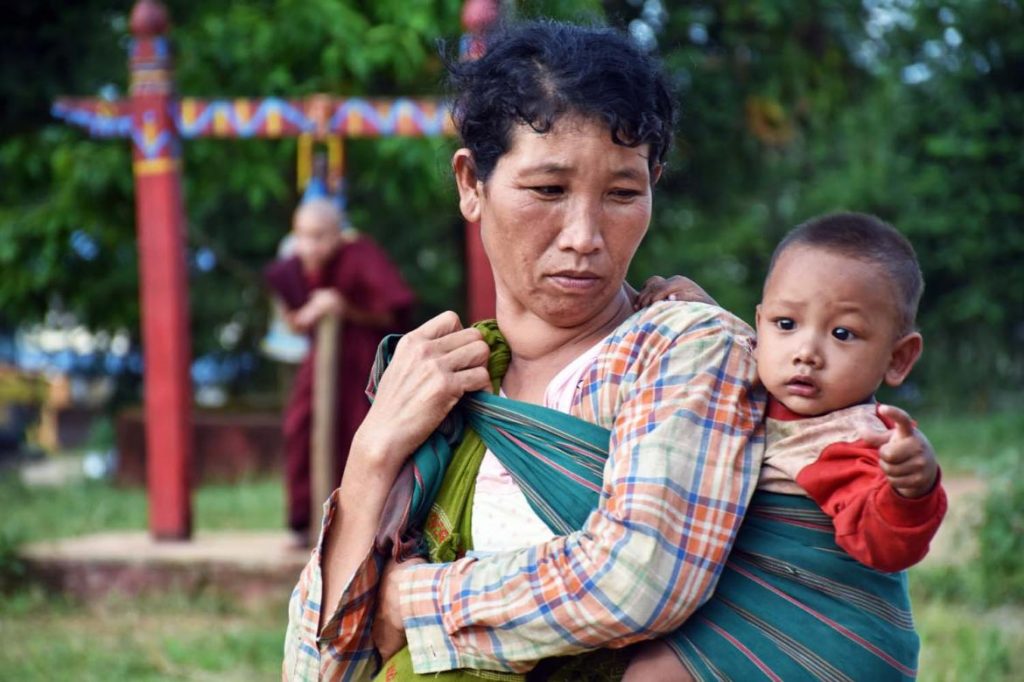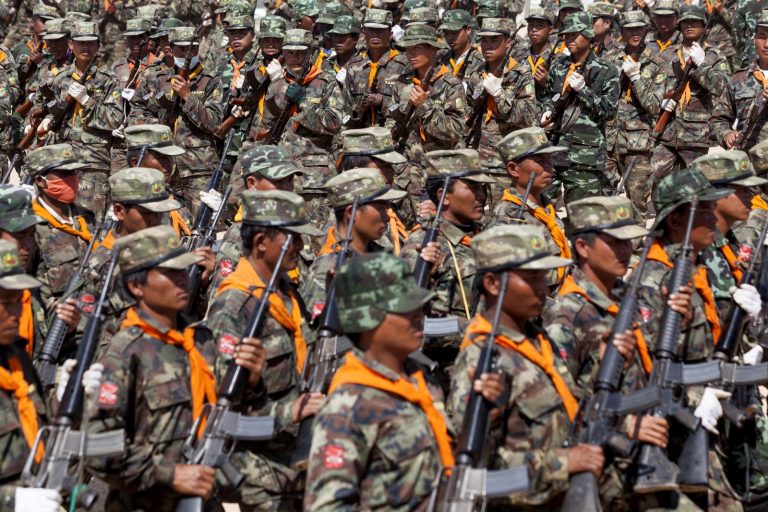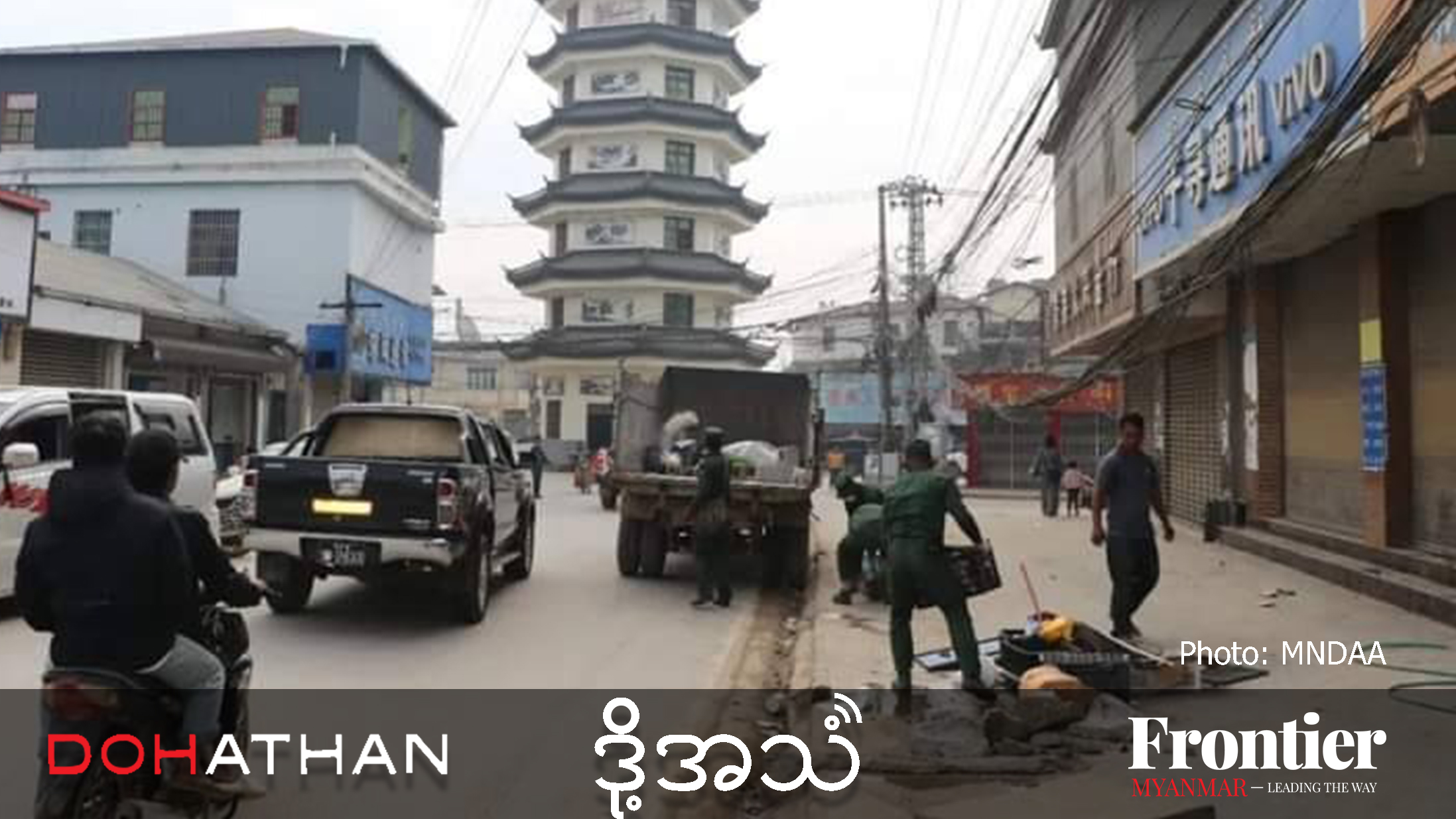Local responses to crises can be more effective, relevant and timely than those by external actors, as powerfully demonstrated during the fighting that erupted in northern Shan State last August.
By MATT WALSH | FRONTIER
Myanmar woke on the morning of August 15, 2019, to news that the Brotherhood Alliance had conducted a series of attacks on government targets in the west of northern Shan State and in neighbouring Mandalay Region.
Among the targets were the Defence Services Technical Academy at Pyin Oo Lwin in Mandalay Region, and key infrastructure targets in northern Shan, the choice of which brought a predictably severe reaction from the Tatmadaw.
Over the next 10 days, heavy fighting convulsed much of northern Shan State, as forces from the Tatmadaw and Brotherhood Alliance – comprising the Ta’ang National Liberation Army, Arakan Army and Myanmar National Democratic Alliance Army – battled for control of key highways, bridges and inter-township checkpoints.
Most of the fighting occurred near the main population centres, such as Kutkai, Hseni, and even Lashio, forcing civilians to seek refuge at monasteries and churches. As is usual in such situations, a range of actors, including local community-based organisations, national non-government organisations, international NGOs, United Nations agencies, and church and social groups, sprang into action to support the displaced.
Support more independent journalism like this. Sign up to be a Frontier member.
In the tragic history of civil war in Myanmar, the fighting, displacement and humanitarian response after August 15 may not seem unique. However, the nature of this humanitarian response is worth examining in more detail, in order to draw lessons and to improve future responses.
The background
The political and social context of northern Shan defies succinct summarisation, but it is useful to highlight some key factors underlining the August 2019 clashes and displacement. Northern Shan is one of the most complex conflict environments on earth, with at least eight ethnic armed groups operating and/or claiming territory in the area. More than 30 government-allied pyithu sit (People’s Militia Forces) man checkpoints, support the Tatmadaw, and engage in legal and illegal business activities. The Tatmadaw maintains a heavy presence, with its Northeast Command overseeing extensive operations involving the use of infantry, armour and air assets.
Although northern Shan has a long history of conflict, the most recent phase followed the breakdown of a 17-year ceasefire between the Tatmadaw and the Kachin Independence Organisation in neighbouring Kachin State, in July 2011.
This resulted in heavy clashes in both states and created a large population of displaced civilians. An unending cycle of small-scale skirmishes and displacements has followed, creating in northern Shan a protracted displaced population of over 8,000 as of August 2019, in 30-plus camps. Many more are displaced for a short time but then return home.
Those forced to flee their homes reflect the ethnic and linguistic diversity of northern Shan, and include Kachin, Ta’ang, Kokang, Lisu, Myaung-zi (Hmong) and others. Many have fled their homes multiple times to escape fighting.

Children displaced by recent fighting in northern Shan State eat at a monastery in Kutkai Township. (Steve Tickner | Frontier)
The humanitarian response
From August 16 to 23, thousands of civilians fled their homes to new displacement sites in northern Shan. For those lucky enough to reach Lashio or Kutkai, there was a diverse, multi-faceted response to meet their basic needs, with the government’s Department of Disaster Management, UN agencies, NGOs and INGOs, local ambulance associations, and religious and business groups working together to ensure they had food, shelter and sanitary living conditions.
However, only a portion of the displaced reached the main cities and relative safety. What happened to the internally displaced persons who did not reach safety because of fighting on main roads and bridges? How did those IDPs survive and protect themselves during that period?
The case of Nant Salat, a small town east of Hseni, is illustrative. On August 17, more than 500 IDPs, mostly women and children, and mainly Chinese, Kachin and Myaung-zi, streamed into the town from three villages to the east, fleeing clashes on the main road to the Kokang Self-Administered Zone. As fighting raged closer to Hseni, the IDPs were trapped in Nant Salat, and sought refuge in the compounds of a Kachin Baptist church, a Roman Catholic church, a Lisu Baptist church, and the homes of townspeople.
Community members, community-based groups, church leaders and the IDPs themselves quickly mobilised, organising rotating cooking teams, and assigning people to negotiate with the private sector, including rice vendors and local farmers, to acquire enough food either through donations or pledges of future payment. Others coordinated with local Department of Disaster Management officials to acquire whatever rice was locally available, and CBO leaders gave emergency cash grants to households to assist with basic needs and support future returns.
Because the fighting made main roads impassable and prevented external providers of humanitarian support from accessing the area, church leaders provided real-time updates, including needs assessments, to local NGOs such as Karuna Mission Social Solidarity and Metta.
After roads opened on August 22, a convoy carrying staff and aid from NGOs and INGOs arrived at the camp to provide further support, including materials for shelter, psycho-social counselling and mine risk education.
Another example is from Nant Pha Ka, a strategically important area on the main road between Kutkai and Muse, which also links Kutkai with Namhkan town. At Nant Pha Ka, CBO and religious leaders monitored approaching fighting with trepidation on August 21. Realising they were cut off and could not flee, the CBOs and religious leaders prepared their communities as best they could.
Bunkers were dug in back gardens, and vulnerable residents, including the elderly, the sick and pregnant women, were moved to locations believed to be safer, such as church compounds. Although banks in nearby main towns had closed because of the fighting, church leaders used an informal money transfer mechanism to put cash in people’s hands, for their immediate needs and for after the conflict abated. As in Nant Salat, community leaders maintained constant contact with the larger NGOs and INGOs that had been providing support, ensuring that they were able to respond immediately to meet the needs of IDPs when roads re-opened.
The most harrowing example involved communities in the Par Gyo area, southwest of Kutkai town. As fighting to the north and south neared their villages on the evening of August 20, their escape options rapidly diminished. Even if evacuation by road was possible, there was not enough vehicles. A group that included 136 children, including 13 infants, and some ill and elderly people, made the difficult decision to flee on foot through the forest to churches in the Garleng area, about 15 kilometres to the west.
Led by local CBO staff they made a difficult evening trek through the mountains in driving rain and arrived safe but exhausted in the Garleng area at about 11pm. They received support from a coalition of local CBOs, as well as larger NGOs such as Metta and TSYU, which provided assistance with shelter and the installation of latrines, food and cash distribution, and protection interventions such as mine risk education. It was not until September 3 that all the villagers were able to return to their homes.

Volunteers help residents sheltering at a monastery in Mong Tin village, Kutkai Township, after they were displaced from neighbouring Kone Sar village by Tatmadaw mortar fire on August 17, 2019. (Steve Tickner | Frontier)
If it’s not broke, don’t fix it
The key characteristic of all of the above responses is that local residents, and in most cases, women, exercised their own agency in flexibly responding to crisis, without the formal support of actors outside their communities. Farmers, pastors, monks, traders, village heads, grandparents and mothers all negotiated, organised, mobilised, fled, hid, manipulated and did whatever else was necessary to survive on their own collective initiative.
This was not extraordinary. In any crisis situation in northern Shan, or elsewhere in Myanmar, it is always local residents who are the first responders. The popular image common in Western media depictions of humanitarian responses, that of blue-vested saviours, is largely false. As demonstrated in northern Shan, it is the local communities who are the first responders.
Analysing these highly localised emergency responses provides keys to understanding how external actors can better engage with and support these processes. As with most similar contexts, people in northern Shan have an unparalleled understanding of the dynamics that underpin the conflict-affected, impoverished, and contested spaces in which they live. In navigating shifting and often-divergent priorities, and demands from ethnic armed groups, the Tatmadaw, militias, government authorities, traders, community and religious leaders, moneylenders, and others, an immense amount of accumulated knowledge and understanding is drawn on to respond to threats and crises.
However, the broader infrastructure of externally led aid and development in northern Shan seems to be largely unaware of this vast reservoir of localised knowledge and understanding. Despite commitments under the Grand Bargain, and a professed goal of greater localisation, many organisations and donors still adhere to rigid and hierarchical bureaucratic systems. These systems conceptually privilege and prioritise their own knowledge and expertise, often imposing Western-centric structures on contexts for which they are ill suited.
Consider response coordination as an example. Externally led humanitarian response mechanisms privilege the authority of whatever those actors define as the primary coordination mechanism in that context. Depending on the mandates and the cluster-system structure rather than the context, coordination is led by the United Nations refugee agency, UNHCR, or the UN Office for the Coordination of Humanitarian Affairs – often disregarding whether these agencies are able to be effective and with little appreciation of local, indigenous coordination structures.
Yet, as the above examples demonstrate, highly complex and locally relevant coordination mechanisms already exist and are effective at the local level. Conversely, in a highly complex conflict characterised by access challenges, elite-level structures are incapable of responding in an effective or timely way. It is understandable that Lashio-based coordination structures could do little during the fighting in northern Shan after August 15 because almost all roads were cut.
If that is the reality of much of the humanitarian response to crisis in Myanmar, is it not logical to spend more time and resources on learning from and strengthening existing locally-led mechanisms rather than imposing new, external ones that cannot respond in moments of crisis?
Power in the aid sector
Transforming these structures requires acknowledgement that the distribution of power in the humanitarian sector facilitates the reproduction of ineffective response systems. Whether it’s via inaccessible funding mechanisms, or confusing English jargon, power – in this case meaning the ability to access and distribute resources – is very much centred at the level of actors external to the community.
It doesn’t have to be this way. A robust literature review exists that highlights the various ways in which external actors can support localised responses to crises, including previous examples from Myanmar. Examples from around the world show that localised responses can be more effective, relevant and timely, and also increase self-reliance, reduce dependency, avoid waste, and build solidarity and resilience among and across communities.
In Myanmar, there are various ways external actors can take immediate practical steps towards supporting localised responses to crisis. They can request capacity building from organisations with direct experience in local response and agency, such as Paung Ku, the Karen Human Rights Group, or KMSS, instead of offering it to them, as is so patronisingly common. INGOs can advocate to their donors that funding mechanisms should adapt to local realities and contexts, prioritising local responders, practicality and speed. Those responsible for coordination can work with community leaders to understand what exists, and analyse, learn from and strengthen it with relevant inputs and support, and help build networks across communities.
As the recent displacements in northern Shan so starkly illustrate, local communities are always the first responders to crisis. It is no longer defensible to refuse to acknowledge this, or fail to take meaningful steps to make local responses the focus and complement them, rather than the other way around. Although many external actors have taken positive steps in this direction, there is more to be done. Transforming the dynamic and re-centering power to communities will not occur because of another workshop in an upmarket Yangon hotel. It will occur through sitting down with local communities and listening, learning and genuinely committing to adapt approaches that reflect their realities. The people of northern Shan deserve nothing less.







